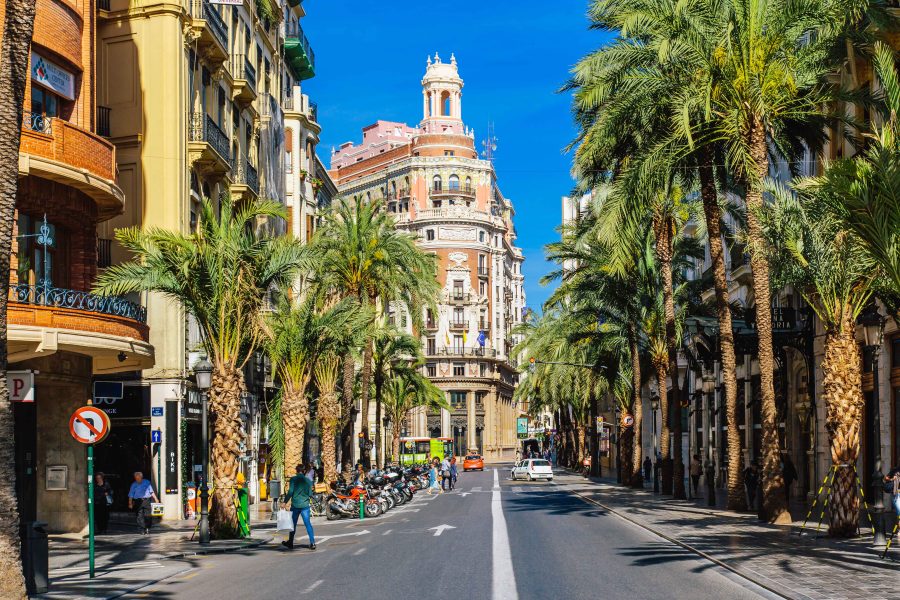For more inspiration, discover our Spain vacation packages.
Inviting beaches? Check.
Cities of unrivalled beauty and architecture? Check.
Delicious food you’ll be craving for months afterwards? Check.
Whether you’re a foodie, culture-lover, adventurer, beach baller, or a little bit of everything, you can’t go wrong with Spain. Full of unique experiences and known for hosting a vibrant lifestyle, you might come to the conclusion that Spain won’t suit your budget – but you’d be wrong. After you’re done reading this article you’ll no longer be asking questions like “How much money do I need to go to Spain?” or “How much much does it cost to go to Spain for 2 weeks?” You’ll have all the answers!
Without further do, here’s how you can spend two weeks in Spain for every budget (updated 2024).
Top budget tips
 Mallorca, Balearic Islands, Spain
Mallorca, Balearic Islands, Spain
Spain, has been a tourist magnet since the 60s and is no longer the cheap destinations of days past. Not to worry, it’s also very doable on a budget as long as you prioritize your spending. Just make sure to know what you want to get out of your visit (spoiler: this is definitely a place you can get lots out of).
Peak season is the Northern Hemisphere’s summer holidays, from June to August, as well as during Christmas and New Year. These times are extremely busy and prices take a big hike so it’s best to avoid the most-visited cities and destinations. Climate is another factor to consider! If you’re aiming for beach hair and tan-lines you’re all set but, if you want to do some sightseeing without melting, the shoulder season will fit both your travel style and your wallet.
In Spain, the official language is Spanish, as expected. However, different dialects of Catalan is spoken in Catalonia, the Balearic Isles, and Valencia. If you hit Bilbao you’re likely to hear Basque and in Galicia, Galician (surprise!) is spoken, closely resembling neighboring Portuguese.
How to travel in Spain on a shoestring budget
How much you’ll need for two weeks: €750-1000.
Cost per day: €60-70 or USD $70-80.

Sure, of course you want to see the big ones, Barcelona, Madrid, the Alhambra in Granada… That’s totally doable just skip the peak season, avoid major events like Pride or Easter and seek out the alternative, less-visited events for a unique and memorable time. Spain is, after all, enjoyable all year around and small things like beach chills, cheap but flavorful eats and architecture walks (free instagram stories included) are a big part of what it’s about!
Make use of the affordable public transport, it’s amazingly well develop across the country and especially American visitors will be amazed by the speed and connectivity. Also, use car-pooling services like ‘Bla Bla Car’ that run well in Spain. It can save you a ton of money!
Breakdown
Accommodation
In major cities and main tourist destinations, a dorm bed in a hostel will set you back around €25-45 a night, depending on your preferences.
Food
The good thing about Spain is its love of small plates, or pinchos (or pintxo if you’re in Basque country). Ordering a few of these to share (if you have a travel companion) in a non-touristy area will be about €3-6 a plate. For a day’s worth of food, you’ll be paying around €12-18.
Drinks
Beer and wine can range from €2 to €3.50, and maybe more in popular areas. When on a budget, after you’ve gone sightseeing, head out of the main tourist areas to the neighborhoods where locals live for cheaper drinks. It’s not only cheaper but also more authentic!
Transport
Bus and metro rides will vary depending on which city and region of Spain you’re in. As a guide, single bus and metro rides can be from 70 cents (usually more so the case in Northern Spain) to €1.50 or €2. Many cities offer multiple rides for a set amount, such as Barcelona, which offers 10 trips on all the local transport for €9.45. You can also bike of course, with rental bikes going for around €10 per day and e-bikes twice that amount, Barcelona is a great example.
Experiences
Museum entry can be free or up to €15 or may be slightly more for a guided tour of the Sagrada Familia in Barcelona, for example. In wine regions, a vineyard tour may cost €15. Look out for specific days of the week or month when some paid attractions offer free entry or tours may be discounted. Avoiding the weekend, you’ll probably have a more private experience as well.

Food is definitely one of the highlights of my visits to Spain. Each region has its own speciality, from paella in Valencia, to pintxos in the Basque Country, and the simple (yet delicious) bread with tomato in Catalonia. The Spanish also eat a lot of tapas, so you can share several small dishes between friends, to try even more tasty food!
For travelers on a budget, bars in Andalusia and other regions in southern Spain often include free tapas when you order drinks. Small dishes of tortilla, seafood, patatas bravas (fried potatoes in spicy sauce) will soon add up to a whole meal, so this can be a great way to save money! – Claire, Tales of a Backpacker
How to travel in Spain on a mid-range budget
How much you’ll need for two weeks: €1,150-2,100.
Cost per day: €80-150 or USD $95-180.
Breakdown
Accommodation
A double room in a comfortable, mid-range hotel will be €70-150 per night. Avoiding big hotel chains and going boutique can give your room more character and the local flair Spain is known for.
Food
Dining out for lunch and dinner at local restaurants will cost €20-40. The Spanish love to lunch light with a tortilla, ask for a Spanish one if you want potatoes in it and for a French if you prefer it without.
Drinks
Beer and wine will be up to €3 (or more in tourist areas) while cocktails can be from €12 in a nice bar.
Transport
For a mid-range budget, we recommend public transport – ranging from 70 cents to €2 a trip. Train can also be an affordable and comfortable way to go from one city to another. Hiring a car for a portion of your vacation, which will set you back around €25 a day.
Experiences
On a mid-range budget, you can be more lenient with how many of these paid attractions or experiences you can enjoy. Consider a hop-on-hop-off tour or join a bicycle day tour with a local guide.

How to travel in Spain on a luxury budget
How much you’ll need for two weeks: €2,800+
Cost per day: €250+ or USD $270+
Breakdown
Accommodation
A double room in a top-end hotel will cost from €200 per night in most tourist cities like Barcelona and Madrid, and slightly less elsewhere.
Food
Fine dining for lunch and dinner costs €150-200.
Drinks
In trendy, quaint or more upscale bars, wine and beer can cost around €5 a glass or bottle, while cocktails will set you back from €12, usually, more the more touristy or renowned the bar is. Rooftops is always the go but often get full so place a reservation if you wan to be sure.
Transport
Hiring a car will cost from €30 a day. Taxis range in price depending on where you are in Spain, but based on Barcelona (which will be one of the more expensive areas), a ride will cost a minimum of €7, with additional supplements for things like luggage, more than four people, or going to the airport or cruise terminal. Uber and Bolt are available.
Experiences
On a luxury budget, you can take guided tours through all exhibitions and churches that offer it and splurge on multiple wine tastings. You may even consider adding a few short two or three-day tours to enrich your travels in Spain.
I lived in Spain for 4 years and I had to live in several cities due to my job. That’s how I ended up living in Malaga, Barcelona, Madrid, Seville and finally Tenerife. During my stay in each city, I traveled as much as possible, thus I got to see many not so know, rather remote gems of Spain.
But, even after 4 years of intense Spain travels. Andalusia has my heart. The Southern region of Spain has so much variety when it comes to natural landscapes, beaches, impressive historical buildings and vibrant traditions. Cities differ a lot: whereas Seville has a more serious and proud character, Malaga is more international and has that laid-back beach vibe. Cordoba and Granada have probably the most impressive Moorish heritage in the world. In Andalusia, you’ll be spoilt for choice when it comes to quality food, hiking trails, gorgeous beaches and vibrant fiestas. – Paulina, Paulina on the Road


